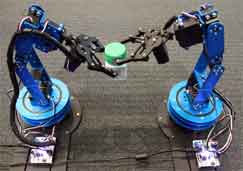An interesting new system from researchers at MIT could use an RFID-based system instead of computer vision to power high speed piece picking robots.
Supply Chain Digest Says... |
 |
| In manufacturing applications, the system could enable robot arms to be more precise and versatile in picking up, assembling, and packaging items along an assembly line. |
 |
What do you say? |
| Click here to send us your comments |
 |
| Click here to see reader feedback |
|
|
As reported on the ScienceDaily web site, based on information from MIT and writer Rob Matheson, the new system developed at MIT uses RFID tags to help robots hone in on moving objects with very high speed and accuracy. The system could enable greater collaboration and precision by robots working on packaging and assembly tasks, or for swarms of drones working together on search-and-rescue missions.
In a paper being presented this week at the USENIX Symposium on Networked Systems Design and Implementation, the researchers show that robots using the system can locate tagged objects within an amazingly low 7.5 milliseconds, on average, and with an error of less than a single centimeter.
The MIT calls the system TurboTrack. It uses an RFID that tag can be applied to any object. A reader sends a wireless signal that reflects off the RFID tag and other nearby objects, and rebounds to the reader.
An algorithm then sifts through all the reflected signals to find the RFID tag's response. Final computations then leverage the RFID tag's movement, even though this usually decreases precision, to improve the positioning accuracy.
The researchers say the system could replace computer vision for some current robotic tasks. As with humans, computer vision is limited by what it can see, and it can fail to notice objects in cluttered environments - such as items in a tote. But RFID signals are not limited by line of sight, and can identify targets without clear visualization, within clutter and even through walls.
To validate the system, the researchers attached one RFID tag to a cap and another to a bottle. A robotic arm located the cap and placed it onto the bottle, held by another robotic arm. In another demonstration, the researchers tracked RFID-equipped nanodrones during docking, maneuvering, and flying. In both tasks, the system was as accurate and fast as traditional computer-vision systems, while working in scenarios where computer vision fails, the researchers report.
If you use RF signals for tasks typically done using computer vision, not only do you enable robots to do human things, but you can also enable them to do superhuman things," said Fadel Adib, an assistant professor and principal investigator in the MIT Media Lab, and founding director of the Signal Kinetics Research Group. "And you can do it in a scalable way, because these RFID tags are only 3 cents each."
(See More Below)
|
CATEGORY SPONSOR: SOFTEON |
|
|
| |
|
|
Such low tag costs would be trival in automated piece picking processes in sectors such as pharmaceuticals and electronics, and might be paid for by the higher speed and accuracy anyways.
 In manufacturing applications, the system could enable robot arms to be more precise and versatile in, say, picking up, assembling, and packaging items along an assembly line. In manufacturing applications, the system could enable robot arms to be more precise and versatile in, say, picking up, assembling, and packaging items along an assembly line.
ScienceDaily notes there have been other systems that have attempted to use RFID tags for localization tasks. But these come with trade-offs in either accuracy or speed. To be accurate, it may take them several seconds to find a moving object; to increase speed, they lose accuracy.
The challenge was achieving both speed and accuracy simultaneously. To do so, the researchers drew inspiration from an imaging technique called "super-resolution imaging." These systems stitch together images from multiple angles to achieve a finer-resolution image.
"The idea was to apply these super-resolution systems to radio signals," Adib says. "As something moves, you get more perspectives in tracking it, so you can exploit the movement for accuracy."
The work was sponsored in part by the National Science Foundation.
What applications do you see for this RFID picking technolog? Let us know your thoughts at the Feedback section below.
Your Comments/Feedback
|